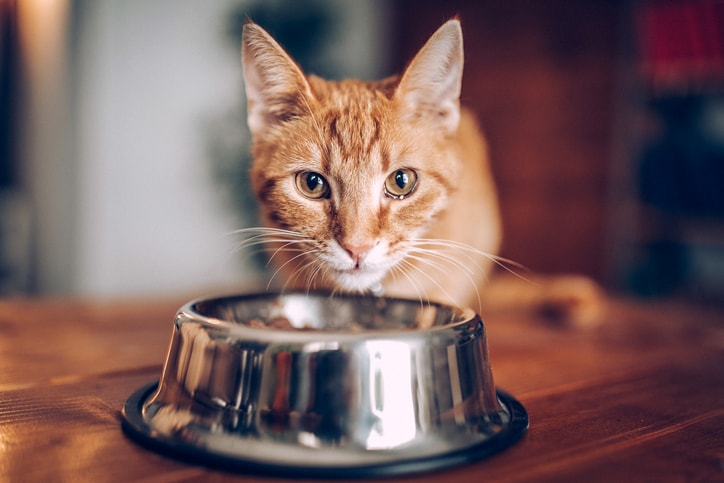Your cat’s bowl is half-full, but they keep meowing hungrily until you top it off. Behaviours like refusing to eat unless their bowl is full, or showing reluctance to eat in general, can be more than just dinnertime dramatics. One possible reason for your cat’s fussiness around food could be an uncomfortable phenomenon known as whisker fatigue, or whisker stress.
Ask a cat behaviour consultant and they will tell you that whisker fatigue comes from constant activation of the cat’s whiskers, which can result in discomfort for the cat. It usually happens if the cat eats from a bowl that they have to stick their full face into.
Below we explore ways of preventing whisker fatigue in cats and how to spot other common reasons cats may experience pain or discomfort while eating.
What is whisker fatigue?
Whiskers are part of the cat’s autonomic — or unconscious — nervous system. Cat whisker fatigue occurs when the whiskers continually receive and transmit an overload of sensory information. This overstimulation of the whiskers causes the cat stress.
For us humans to better understand how cats may experience whisker fatigue, it’s important to recognise that their whiskers are more than just hairs. These delicate structures play a crucial role in how cats perceive and interact with their surroundings.
Whiskers are highly sensitive and embedded deeply in the cat’s skin, with nerve endings that allow them to detect even the slightest changes in their surroundings. They help cats gauge the width of spaces, sense nearby objects and even detect changes in air currents, which is essential for hunting and avoiding obstacles in the dark.
Your cat’s whiskers are, in a way, like a human’s eyelashes. Just as a piece of dust on your eyelash will make you blink, the sensation of your cat’s bowl against their whiskers may be hard to ignore.
Whisker fatigue symptoms in cats
Cats are notorious for hiding signs of discomfort, so the signs of eating issues can be subtle. Here are some of the behaviours to look out for as potential signs:
- Hesitation before eating.
- Only eating from the centre of the bowl.
- Using paws to tip or scoop food or water from bowls.
- Acting hungry but refusing to eat.
- Agitation around mealtimes.
Is whisker fatigue a myth?
Whisker fatigue is a relatively new concept. Many cat experts are sceptical about whether or not this phenomenon truly exists, as it is not widely covered in veterinary textbooks or scientific journals. However, anecdotal evidence suggests that at least some cats prefer to keep their whiskers free during mealtimes.
A 2020 study published by the Journal of Feline Medicine and Surgery evaluated forty cats for whisker fatigue. Subjects did not seem to experience eating issues when fed from a typical bowl, though around three out of four cats seemed to prefer using a whisker-friendly dish. But without more research, it is difficult to provide evidence that whisker fatigue exists.
How to prevent whisker fatigue in cats
Whether your cat shows signs of discomfort or you just want to ensure they have the best possible eating experience, consider feeding them from a shallow plate. Raised whisker-friendly cat bowls can also help, as they allow cats to eat and drink in a more natural posture that reduces whisker contact.
Switching from a water bowl to an automatic water fountain, too, can help improve your cat’s comfort. The flowing water is not only less likely to brush against your cat’s whiskers, but can also help your cat stay healthy and hydrated.
What if it’s not whisker fatigue?
Experts agree that many cats seem to prefer eating from a whisker-friendly plate, but also brought up an important caveat: if eating issues are brushed off as whisker fatigue, a more serious underlying issue may be left unchecked.
Issues that may be mistaken for whisker fatigue include:
- Dental pain. Around 80% of cats over age three have signs of dental disease, according to the Australian Veterinary Association. A painful infection or abscess can make it difficult for your cat to eat.
- Competition between other pets. Your cat may need a private space to eat if they feel bullied over resources like food and water.
- Gastrointestinal issues. These are common in cats and they may experience occasional inappetence, but if your cat frequently skips out on meals or refuses to eat for more than 24 hours, it’s time to visit your vet.
If your cat prefers to graze rather than finish their food at mealtimes, this isn’t really a problem. Many cat parents feed their cats two larger meals, but the cat may prefer to nibble at their food during the day rather than eating it all at once. While this may look like whisker fatigue because the cat eats in shorter bursts, it’s not actually abnormal behaviour for cats.
The bottom line
Based on anecdotal reports from experts and a small study, cats may experience whisker fatigue when eating or drinking from a bowl with high sides. Switching to a flat, whisker-friendly food bowl should help, but if your cat still seems to have trouble eating, make an appointment with your vet. They can provide expert advice tailored to your cat’s specific needs and help you make the best decisions for their comfort and well-being.
